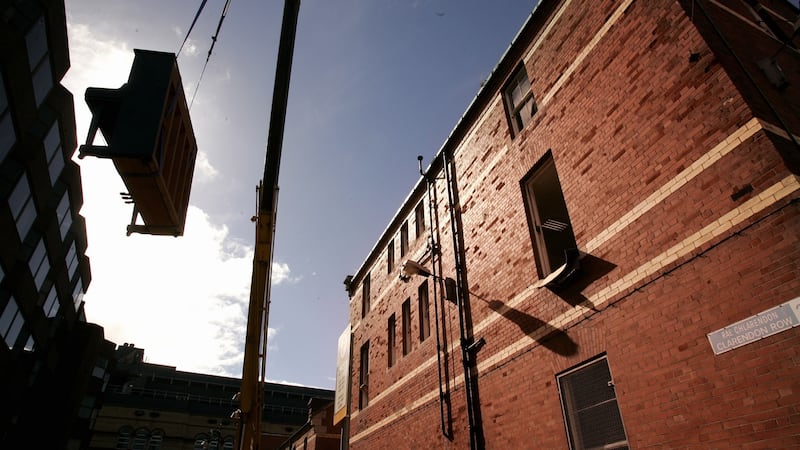Last Monday, the assistant chief executive of Dublin City Council (DCC), Richard Shakespeare, presented a memo to the council’s arts, culture, leisure and recreation strategic policy committee about the future of a building on Chatham Row in Dublin 2. The building, a former music college, was licensed to the hospitality company Press Up for meanwhile use as artists’ studios. I previously wrote about the lack of transparency around Press Up securing this building. Nevertheless, there are now about two dozen individual artists, theatre companies and arts organisations operating from the building. But stop right there: DCC has a plan.
DCC hired a consultant from the UK to assess the future use of the building, and its new ideas include: a fire brigade museum; a venue to display the Lord Mayor’s coach (I’m not joking); a museum for civic collections including the Wide Streets Commission maps. Please remove your head from your hands at this time. In a city starved of artist space, DCC is now attempting to erase some it has actually created.
As per DCC’s own research, the dearth of artist space in the capital is critical. But there has been some good news of late. The Basic Income for the Arts (BIA) pilot scheme, fought for by the National Campaign for the Arts, is a great initiative, and has the potential to keep artists creating and living in Ireland. Pallas Projects, which operates studio space in Dublin 8, has partnered with the Digital Hub on Thomas Street to develop 25 new artists’ studios there. And recently, Dublin Port Company and the Arts Council announced a partnership with the intention of repurposing the former Odlums flour mills site, with Grafton Architects undertaking a feasibility study on the site. This project has the ambition and scale that our starved European capital needs, with plans for artists’ studios, rehearsal rooms, performance spaces and more.
Curiously, DCC isn’t leading any of these initiatives. Maybe that’s a good thing considering that its response to the successful meanwhile-use of Chatham Row is to turn the building into an expensive display case for a fancy carriage. It’s the Arts Council that’s putting €70,000 into Pallas Projects’ plan for the Digital Hub, with the relevant Minister, Catherine Martin — who is turning out to be one of the most quietly innovative in Government — supporting it. And it’s the Arts Council teaming up with Dublin Port Company who are partnering on the flour mills site. Departmental officials have also visited the site and “recognise the potential of this to be a transformational development for artists”.
READ MORE
I don’t have any issues with a civic museum. But it won’t be a popular attraction, and surely there’s another public building that could be used, especially if the one they’re proposing is already functioning as an arts space
The city is still waiting for word on what is going to happen to the Victorian fruit and vegetable market in Dublin 7, which was opened for an event on Culture Night last Friday. Across the river in Dublin 8, the cautionary tale of another market let fall heartbreakingly into ruin pockmarks the city’s cultural psyche. Meanwhile, Aldborough House in Dublin 1, one of the grandest buildings in the city, a Georgian building second only in size to Leinster House, is left to rot, derelict for more than two decades.
I don’t have any issues with a civic museum. But it won’t be a popular attraction, and surely there’s another public building that could be used, especially if the one they’re proposing is already functioning as an arts space. Why kick the artists out? Instead of parking an old fire engine in it, or housing DCC’s weights and measures collection (an actual proposal in the memo), what about something that’s alive? Something contemporary, current, relevant, that actually contributes to the creative vitality of the city? We don’t have to dream this up, it’s already happening in there.

I think people are right to be ambivalent about Press Up’s involvement in the Chatham Row building, while simultaneously having absolutely no issue with artists availing of the space and opportunity it presents. The process should have been more transparent, and I’m uncomfortable with an incredibly wealthy outfit such as Press Up having first dibs when so many artist collectives can’t get their hands on public buildings. I also think: fair play to them for not turning it into another WowBurger. But all that said, given the state of the city, some realism and pragmatism is needed. The studio spaces are working well. I’ve been in the building a few times since it was repurposed, and it feels alive.
What this situation also exposes is that meanwhile-use is just that. Artists need security and stability when it comes to buildings. The Department of Tourism, Culture, Arts, Gaeltacht, Sport and Media, in collaboration with the Arts Council and local authorities (ones with vision, please), needs to develop a new funding strand that is focused on capital grants, where artist collectives and companies can lease buildings long-term at nominal or heavily subsidised rates, or secure funding to buy and own them outright. Co-operative models are particularly useful in this regard. We are entering into an era when an abundance of commercial property will be available. The State — not private investment funds — needs to scoop this property up and redistribute it to cultural and community organisations. Meanwhile-use sounds like a dynamic approach, and it can be, but there’s very little distance between operating within in the cracks of a broken city and falling through them, especially when those charged with helping — in this case DCC’s executive — is so lacking in imagination.














